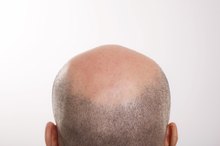Diseases Causing a Change in Hair Texture
Numerous diseases can cause a change in hair texture and volume. According to the U.S. National Library of Medicine and the National Institutes of Health, or NIH, the lips, palms and soles of the feet are the only parts of the body on which hair does not grow 12. The NIH states that hair loss, infections and flaking are among the most common problems associated with the hair and scalp, although there are also certain medical conditions in which the texture of a person's hair changes.
Hypothyroidism
Hypothyroidism is a disease that can cause a change in hair texture. According to the National Institute of Diabetes and Digestive and Kidney Diseases, or NIDDK--a division of the National Institutes of Health--hypothyroidism occurs when the thyroid gland is unable to produce enough thyroid hormones to meet the body's needs 12. One of the most common signs or symptoms associated with hypothyroidism is dry, thinning and coarse hair. The NIH states that thin, brittle hair and fingernails are among the early symptoms of the disease. A person with hypothyroidism may notice an increased amount of hair loss when washing her hair in the shower.
- Hypothyroidism is a disease that can cause a change in hair texture.
- The NIH states that thin, brittle hair and fingernails are among the early symptoms of the disease.
Hirsutism
Bald Patches in Children
Learn More
Hirsutism is a condition that can cause a change in hair texture. The Mayo Clinic website states that hirsutism is a condition of unwanted, male-pattern hair growth in women. Approximately 10 percent of American women have some level of hirsutism. Hirsutism is believed to be caused by diseases that stimulate the production of male hormones known as androgens. Hirsutism may also be a family or ethnic trait, notes the Mayo Clinic website. Hirsutism is characterized by excessive amounts of coarse and pigmented hair on body parts that do not typically experience hair growth in women, such as the face, back and chest. Although there are no hirsutism-related physical complications, the chemical imbalances that cause hirsutism should be assessed by a qualified physician.
- Hirsutism is a condition that can cause a change in hair texture.
- Hirsutism is characterized by excessive amounts of coarse and pigmented hair on body parts that do not typically experience hair growth in women, such as the face, back and chest.
Anorexia Nervosa
Anorexia nervosa is a disease that can cause changes in hair texture 3. According to the Family Doctor website, anorexia is a disease that usually occurs in teenage girls, although it can develop in teenage boys and adults of both genders 3. A person who is anorexic is obsessed with being thin, loses a significant amount of weight and is extremely fearful of gaining weight. An anorexic believes she is overweight even though she may be very thin. The Family Doctor website states that anorexia is more than simply a problem with food or weight: it's a way to use food and weight to manage emotional turmoil or upheaval 3. Anorexics typically have dry skin and thinning hair on the head. Other common health problems associated with anorexia include cold intolerance, depressed immune system and frequent illness, irritability, inability to concentrate and loss of menstrual periods in women.
Related Articles
References
- National Institutes of Health: Hair Problems
- National Institutes of Health: Hypothyroidism
- Family Doctor: Anorexia Nervosa
- Fabbrocini G, Cantelli M, Masarà A, Annunziata MC, Marasca C, Cacciapuoti S. Female pattern hair loss: A clinical, pathophysiologic, and therapeutic review. Int J Womens Dermatol. 2018;4(4):203-211. doi:10.1016/j.ijwd.2018.05.001
- Mirmirani P. Managing hair loss in midlife women. Maturitas. 2013;74(2):119-22. doi:10.1016/j.maturitas.2012.10.020
- Trost LB, Bergfeld WF, Calogeras E. The diagnosis and treatment of iron deficiency and its potential relationship to hair loss. J Am Acad Dermatol. 2006;54(5):824-44. doi:10.1016/j.jaad.2005.11.1104
- Park SY, Na SY, Kim JH, Cho S, Lee JH. Iron plays a certain role in patterned hair loss. J Korean Med Sci. 2013;28(6):934-8. doi:10.3346/jkms.2013.28.6.934
- Guo EL, Katta R. Diet and hair loss: effects of nutrient deficiency and supplement use. Dermatol Pract Concept. 2017;7(1):1-10. doi:10.5826/dpc.0701a01
- Vincent M, Yogiraj K. A Descriptive Study of Alopecia Patterns and their Relation to Thyroid Dysfunction. Int J Trichology. 2013;5(1):57-60. doi:10.4103/0974-7753.114701
- Davis SR, Castelo-branco C, Chedraui P, et al. Understanding weight gain at menopause. Climacteric. 2012;15(5):419-29. doi:10.3109/13697137.2012.707385
- Gupta AK, Charrette A. Topical Minoxidil: Systematic Review and Meta-Analysis of Its Efficacy in Androgenetic Alopecia. Skinmed. 2015;13(3):185-9.
- American Academy of Dermatology. Thinning hair and hair loss: Could it be female pattern hair loss?
- Harvard Health Publications. Treating female pattern hair loss - Harvard health.
- U.S. National Library of Medicine. Female pattern baldness.
Writer Bio
Martin Hughes is a chiropractic physician, health writer and the co-owner of a website devoted to natural footgear. He writes about health, fitness, diet and lifestyle. Hughes earned his Bachelor of Science in kinesiology at the University of Waterloo and his doctoral degree from Western States Chiropractic College in Portland, Ore.








